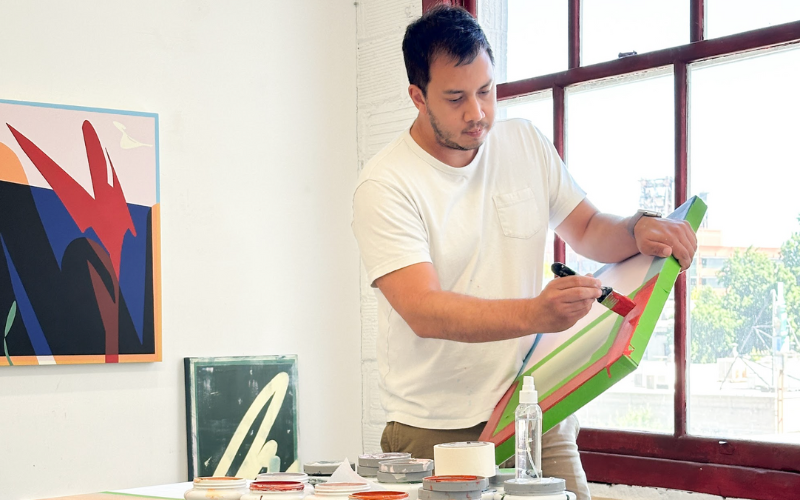 “Success is arbitrary and ill-defined, and ultimately not up to us, so it shouldn’t be the target. Just make what you want to make. Anything else is a bonus.”
“Success is arbitrary and ill-defined, and ultimately not up to us, so it shouldn’t be the target. Just make what you want to make. Anything else is a bonus.”
This mindset has carried Artwork Archive's Featured Artist Adrien Saporiti through years of experimentation, learning, and growth as a self-taught artist.
Now based in Portland Oregon, Saporiti brings a blend of street art, graphic design, and abstract painting into his studio practice. His color choices are intentional. His marks are confident, layered, and often shaped by his own handwriting—but treated more like form than text.
Language, identity, and connection have long been part of this artist's visual vocabulary, shaped by his upbringing in the American South as a mixed-race artist with immigrant roots. His recent paintings explore communication through gesture and instinct rather than clarity, prioritizing shared feeling over any single particular meaning.
Artwork Archive had the chance to chat with Adrien Saporiti about his creative process, how he welcomes interpretation of his work, and why Artwork Archive has become such an important tool in his art career.
You can see more of his work on Discovery and learn more about his art practice below: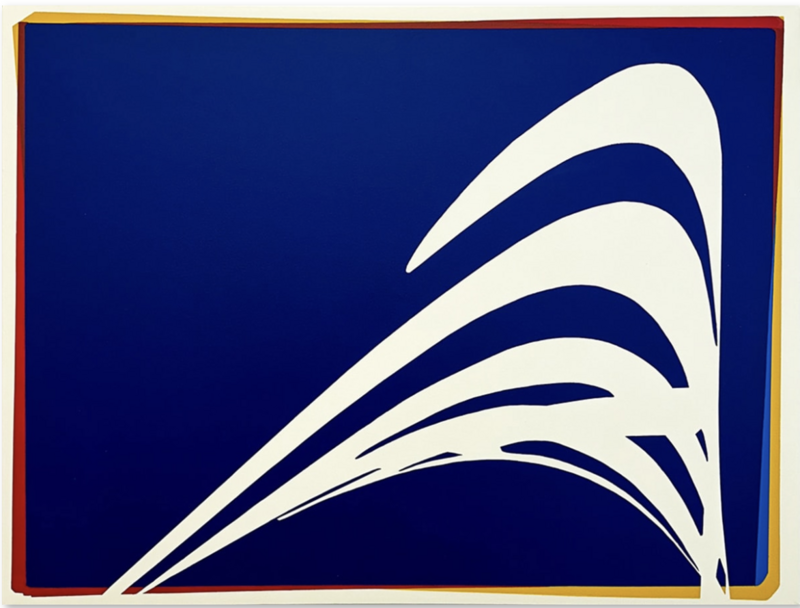
Adrien Saporiti, Virtue Signals, 2024, 30 x 40 x 1.5 in
Inside Saporiti's Process:
There's no single formula in Adrien Saporiti's studio as he moves between mediums with a concept-first mindset. Some ideas live in his mind for a while before they’re given form: “Often I’m working on an idea in my head before anything else,” he says. “Then depending on the style, I may move to designing it before painting it.”
The process might include sketches, tape, direct paint, or some combination of all three. With one piece, he might sketch or design it digitally. With another, you might find him taping off sections or diving straight in. But no matter how it starts, each piece ends with a decision: stop, or keep going. To know which is which, Saporiti listens for the internal cue: “Will adding to this make it better, or make it worse?”
A Minimalist at Heart
Adrien Saporiti brings a designer's restraint and a street artist's adaptabiity into his studio practice. Years spent moving between public art and graphic design taught him how to strip things down to what matters, and how to let each piece guide the process. “My general approach, whether it’s public art, graphic design, or painting, always seems to default to minimal, with high impact.”
Rather than committing to one particular genre, he moves between them fluidly, treating each as a medium that serves the needs of the work. “Everything’s case by case for what’s required to make the best version of what I’m trying to make.” While he often leans toward minimalism, for this artist, it's more about knowing what to hold on to, and what to leave out.
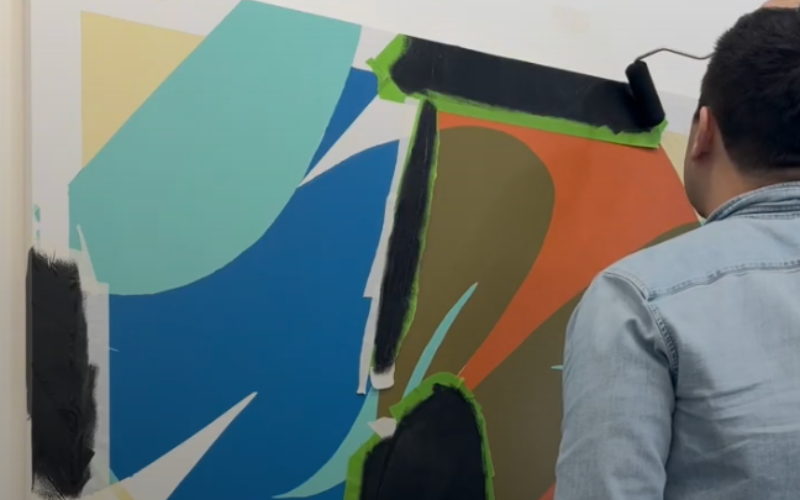
Adrien Saporiti pictured with a WIP. Photo courtesy of the artist
Growing Up Between Cultures—and Finding a Visual Voice
Born to an immigrant parent and raised mixed-race in Tennessee during the ’90s, Saporiti has a background that naturally shapes the lens through which he sees the world. “I grew up in Tennessee in the ’90s; I feel like that’s pretty self-explanatory.”
Rather than literal stories, the deeper theme that continues to surface throughout his work is communication. For him, the question of communication runs deeper than words. It’s about the experience of trying to connect when language doesn’t always land. “More universally, I think a lot of artists feel misunderstood or have a hard time communicating,” he reflects, “and that’s some part of why they make art.”
He’ll Take Curiosity Over Clarity
While many artists talk about “getting a message across,” Saporiti isn’t fixated on controlling the narrative. “I’m more interested in what others see in the work than expressing something specific,” he explains.
For the most part, those interpretations are welcome. But now and then, someone insists on defining the work for him. “The only time it’s been surprising is when they insist on telling me what I was thinking and what my intention was. But that’s more of a them problem, so I kind of just nod and say, ‘thank you for the insight.’”
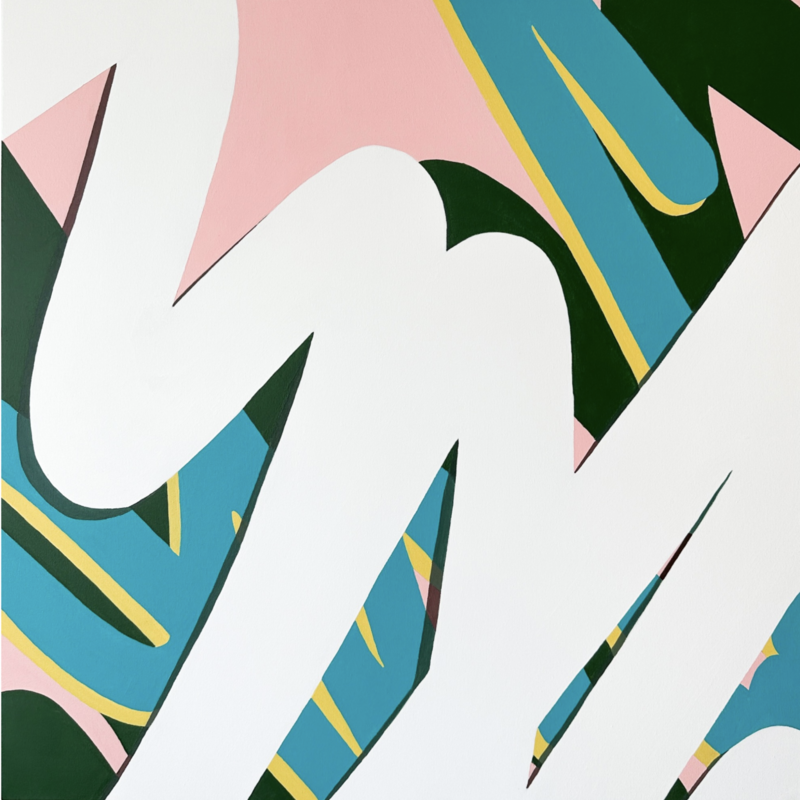
Adrien Saporiti, Only Built for Cuban Linx, 2023, 30 x 30 x 1.5 in
The Success Myth, and Why Van Gogh is Still the Example
This week's Featured Artist isn’t in it for the sales or recognition (and he doesn’t think you need to be either). “I regularly remind myself that Van Gogh, arguably the most famous artist to ever live, only sold two paintings while he was alive… to his brother,” he points out. “If you’re still alive, making art, and can sell three paintings in your career, congratulations, you’re already more successful than Van Gogh was when he was alive.”
That perspective helps him stay focused on the work itself. “Success is arbitrary and ill-defined, and ultimately not up to us, so it shouldn’t be the target. Just make what you want to make. Anything else is a bonus.”
What Keeps the Work Going—Even When It’s Hard
There’s no big breakthrough moment that defines Adrien Saporiti’s journey. When asked about the biggest challenge he’s faced, he doesn’t point to one moment. “The truth is, every day is a challenge. I think that’s just being an artist.”
From financial uncertainty to difficult clients to the unpredictability of social media, he’s navigated it all. For him, staying grounded means staying honest—about money, networking, algorithms, or whatever else might be in the way. “The only way I know to overcome anything is to be realistic about what the outcome is or should be, and then decide to either keep going, or accept it and pivot. Either option is fine as long as it’s done genuinely.”
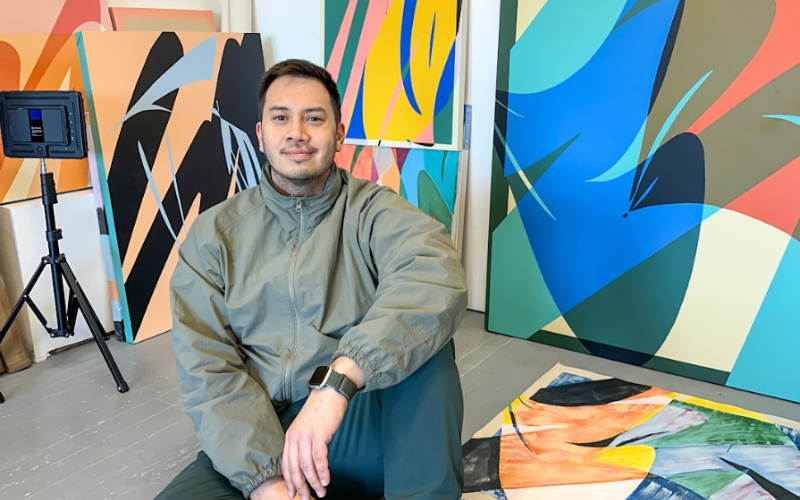
Adrien Saporiti in his studio. Photo courtesy of the artist
A Small Shift That Made a Big Difference
When Adrien Saporiti first signed up for Artwork Archive, it was a practical decision. As he spent more time with the platform, he realized how much it could streamline parts of his career. “It seemed like it could be useful, and as I explored it I started to see where and how it could add to, and simplify, a lot of aspects for me.”
The most-used feature in his workflow is also the most straightforward: Inventory Reports. “It saves a fair amount of time to have everything in one place instead of searching through folders and my memory,” he says. “And it really elevates my professionalism when a gallery or potential client gets a neatly organized document rather than a Dropbox link to 15 files for them to sort through.”
While he values the resources built into the platform—like grants and opportunity listings—it's the simple tools that help him stay efficient and present in his studio practice.
Where to Find the Next Yes:
Did you know? Artwork Archive’s Resources page is full of vetted artist grants, calls for entry, and free webinars. Create an account to access them any time you need new opportunities or professional guidance.
For Anyone Just Starting Out
Adrien Saporiti doesn’t pretend there’s a straight line to follow. And, in fact, his advice for other artists starts with a bit of humor: “Can you do anything else? Anything at all? Do that. But if you can’t, congratulations, you’re an artist.”
All jokes aside, there's something real here: a call to stay focused on what actually matters. “At the end of the day it’s all about making good work and genuinely trying to connect with people. There’s no magic pill, no formula or course, and no trend or gimmick that’s the solution.”
He urges artists to follow what pulls at them most. “Make what excites you—what you're compelled to create—and then share it with people, preferably in person. This is not a career in the sense of there’s a retirement and a gold watch at the end of it. This is for life. You'll have incredible but you may also face detours and unexpected stops.”
There’s no map, no promised destination. But for Adrien Saporiti, the path (detours and all) is the point.





